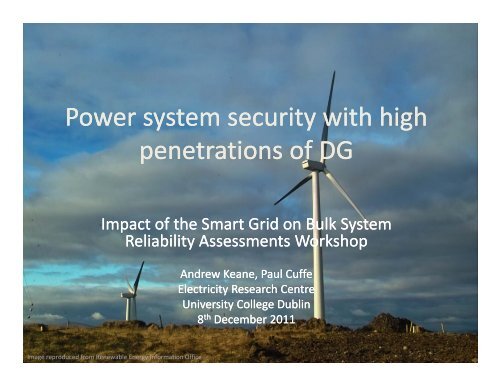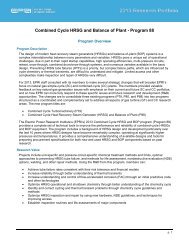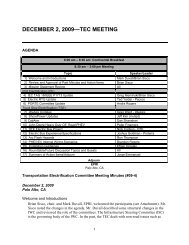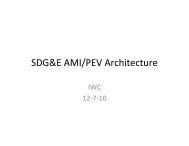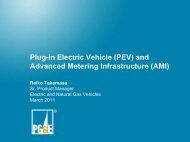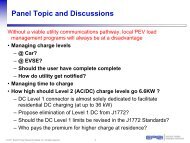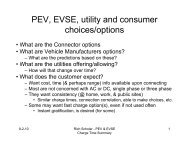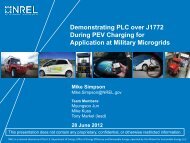Power system security with high Power system security with high ...
Power system security with high Power system security with high ...
Power system security with high Power system security with high ...
You also want an ePaper? Increase the reach of your titles
YUMPU automatically turns print PDFs into web optimized ePapers that Google loves.
<strong>Power</strong> <strong>system</strong> <strong>system</strong> <strong>security</strong> <strong>security</strong> <strong>with</strong> <strong>with</strong> <strong>high</strong><br />
<strong>high</strong><br />
penetrations of DG<br />
Impact of the Smart Grid on Bulk System<br />
Reliability Assessments Workshop<br />
Image reproduced from Renewable Energy Information Office<br />
Andrew Keane, Paul Cuffe<br />
Electricity Research Centre<br />
University College Dublin<br />
8 h th December 2011
Distribution Transmission Interface<br />
• Key y boundary y point p<br />
– Physical<br />
– Organisational<br />
• Physics of the <strong>system</strong> have no respect for<br />
organisational boundaries<br />
• High penetrations of DG mean conventional plant<br />
g p p<br />
will be decommitted<br />
– Instantaneous DG penetrations of 25% hit in Ireland
Synchronous Machine Capability<br />
Actiive<br />
<strong>Power</strong> (MWW)<br />
50<br />
40<br />
30<br />
20<br />
10<br />
0<br />
‐35 ‐15 5 25 45<br />
Reactive power (MVAr)<br />
Sync<br />
Machine
Wind Turbine Reactive <strong>Power</strong><br />
1<br />
0.8<br />
0.6<br />
0.4<br />
Active<br />
<strong>Power</strong> (pu)<br />
0<br />
-0.7 -0.5 -0.3 -0.1 0.1 0.3 0.5<br />
Reactive <strong>Power</strong> (pu)<br />
0.2
Distribution/Transmission Interface<br />
Active <strong>Power</strong><br />
(MW)<br />
50<br />
40<br />
30<br />
20<br />
10<br />
Raw (P,Q)<br />
99% Reliability<br />
0<br />
‐35 3 ‐25 2 ‐15 ‐5 5 15 225<br />
Reactive <strong>Power</strong> (MVAr)<br />
Cuffe, P., Smith, P. And Keane A., “Effect of Energy Harvesting Network Reactive Support on Transmission System Voltage Performance”,<br />
CIRED, Frankfurt, June 2011
P‐Q Measurements at 110 kV Bus<br />
1<br />
08 0.8<br />
0.6<br />
04 0.4<br />
Active<br />
<strong>Power</strong> (pu)<br />
0<br />
-0.7 -0.5 -0.3 -0.1 0.1 0.3 0.5<br />
Reactive <strong>Power</strong> (pu)<br />
0.2
Summary Points<br />
• AVR capability of synchronous machines needs to<br />
be replaced<br />
– Detailed requirements yet to be determined<br />
• Wind turbines have capability, but if distributed,<br />
network impedance present limitations<br />
• PQ capability can increase hosting capacity of<br />
distribution networks networks or reduce losses or or….<br />
• How can these conflicting objectives be<br />
reconciled?
Challenges<br />
• Enable cost effective, low loss connections for<br />
DG<br />
– While also providing p greactive power p where and<br />
when it is required on transmission <strong>system</strong><br />
• What are the transmission requirements?<br />
– Controlled voltages?<br />
– Supply of reactive power?<br />
– Fault ride through at DG level?<br />
• Reconciliation of TSO and DSO objectives
Potential Solutions<br />
• Increased control of distribution voltages<br />
• New distribution and transmission planning<br />
methods<br />
– Reactive power margin, DG output<br />
• Tools for operation<br />
– Who controls P & Q?


